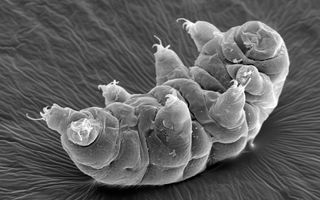Crab Legs Clipart Black and White Draw
Tardigrades probably see in black and white

Chubby, resilient tardigrades — arguably the cutest of all microscopic life — can survive punishing temperature extremes, exposure to the vacuum of space and even being shot out of a gun.
But there's one thing tardigrades can't do: see in color.
Tardigrades are related to arthropods (invertebrates with segmented bodies and exoskeletons), and arthropods can see colors because of light-sensitive proteins called opsins, which play a role in vision and circadian rhythms. Tardigrades have opsins too, but little was known about what they do, so scientists recently conducted genetic analysis in two species of tardigrades, to discover how opsins affected sight in these rotund little moss piglets.
Related: 8 reasons why we love tardigrades
"In general, vision in tardigrades is not particularly well understood," said study lead author James Fleming, a postdoctoral fellow at the University of Oslo's Natural History Museum in Norway. Scientists have previously analyzed tardigrades' eyespots, which are simple structures made of only a handful of cells (though some species are eyeless) and have tested how those tardigrades responded to light, Fleming told Live Science in an email.
"Their visual response really varies from 'directly moves away from dark towards light or vice versa' to 'begins to move when exposed to light, trying to search for a place that is not light,'" he said. Tardigrade eyes have no lenses, which suggests that they can't form images. That means their response to light "might be more directional, or intensity-based rather than image- or space-based," Fleming said.
In the animal group Ecdysozoa — "molting animals," which includes arthropods, worms such as nematodes, and tardigrades — the opsin group that's primarily associated with vision is rhabdomeric opsins, or r-opsins. Animals with color vision typically have multiple copies of these so-called visual opsins, because "each opsin responds to a specific range of wavelengths of light," Fleming said.
"In humans, most eyes have one visual opsin that best responds to red, one to green and one to blue — the remaining colors that we see are shades and mixes of them," he said. (Color blindness can result from the absence of one or two of these opsins.)
In 2018, Fleming and other researchers discovered that tardigrades had multiple copies of visual opsins, suggesting that tardigrades "might be able to distinguish colors," the scientists reported July 13 in the journal Genome Biology and Evolution.
From egg to adult
In the new study, the authors looked at genetic data in two tardigrade species, Hypsibius exemplaris and Ramazzottius variornatus, and went opsin-hunting in the tardigrades' transcriptomes — collections of DNA information that are transcribed as RNA, which means they will eventually be translated into proteins that serve a purpose in the body. Transcriptome analysis can tell researchers when genes are activated and when they're dormant in an organism's cells, according to the National Human Genome Research Institute in Bethesda, Maryland.
H. exemplaris and R. variornatus both had very well-documented transcriptomes, the authors reported. They identified multiple r-opsins in tardigrades that were associated with vision, and they tracked opsin activity in the two tardigrade species during three stages of their life cycle: egg, juvenile and adult.
Though both species had multiple copies of active visual opsins, the opsins weren't responsive to different wavelengths of light. Rather, certain visual opsins were activated in different amounts during a given life stage, the study authors reported.
Surprisingly, some of those opsins were most active when tardigrades were still eggs — not exactly a time when you'd expect tardigrades to have much use for vision at all, Fleming said.
"Like a lot of work with tardigrades, this raises loads more questions," he explained. "It suggests that tardigrades might be using some of these opsins for non-visual purposes," but what those purposes might be are unknown, Fleming said.
The scientists concluded that even though they confirmed that tardigrades had multiple visual opsins, "we find it unlikely that they are capable of color vision." However, the presence of multiple and diverse opsins in tardigrades suggests that light sensitivity could influence tardigrade behavior more than previously thought, the researchers added.
"The more we find out about these really lovely creatures, the more questions keep coming up," Fleming said. "They interact with the world around them in a way that is very different to us, and we are still adjusting the focus on our microscope to really see their environment clearly."
Originally published on Live Science.

Mindy Weisberger is a Live Science senior writer covering a general beat that includes climate change, paleontology, weird animal behavior, and space. Mindy holds an M.F.A. in Film from Columbia University; prior to Live Science she produced, wrote and directed media for the American Museum of Natural History in New York City. Her videos about dinosaurs, astrophysics, biodiversity and evolution appear in museums and science centers worldwide, earning awards such as the CINE Golden Eagle and the Communicator Award of Excellence. Her writing has also appeared in Scientific American, The Washington Post and How It Works Magazine.
Crab Legs Clipart Black and White Draw
Source: https://www.livescience.com/tardigrades-cant-see-color.html
0 Response to "Crab Legs Clipart Black and White Draw"
Post a Comment